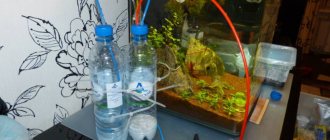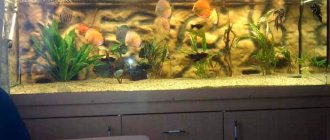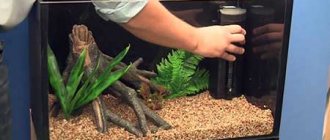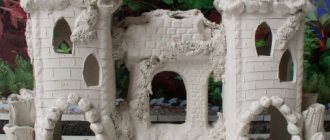Clay for aquarium
Aquarium plants need regular fertilization, just like any type of land-based flora. Clay for the aquarium is a universal feeding, characterized by its availability and ease of use. A real storehouse of useful microminerals, it will be an excellent feed for plants in water.
Experienced aquarists combine different types of fertilizers, taking into account the characteristics of aquatic inhabitants, the main purposes of use and other nuances. There are two types of recharge:
- Solid fertilizers. Tablets, balls, granules are introduced into the soil, through which they gradually seep, feeding the entire plant base;
- The liquid feed is added to the water and absorbed by the leaves of the plants. It is convenient to regulate the concentration of nutrients by simply replacing the water fractions.
What clay is used most often?
Branded products for aquarium maintenance are replacing traditional clay, but there are still enthusiasts who create balls from different types of clay on their own. There are several types of natural fossils:
- Red;
- White;
- Yellow;
- Blue;
- Green.
The mineral composition depends on the color of the fossil. Blue and green clay have the greatest amount of minerals and useful components. It is an excellent absorbent and has antiseptic properties. Blue clay is combined with sand, biohumus and other fractions.
Laterite is an exotic analogue of a domestic fossil
For aquariums, an interesting analogue of the domestic fossil is increasingly being used - laterite (duplarite). This is red soil taken from the tropics. It is rich in iron oxide. Used to form the bottom layer of soil base in an aquarium.
Methods for using clay fertilizer
The simplest method of applying recharge is to form balls from the fossil and place it in the ground. It is advisable to form small rounds that will not cause an excess of minerals in the aquarium water. They can be placed in a special grotto in the aquarium. Another option: on the river bank they look for a place where pure clay comes out and extract several fragments. In a home aquarium, a piece of river fossil is carefully placed under the ground. Stores sell preparations that can be used immediately. Different types of clay (pure or with impurities) have the optimal amount of essential microelements. They can also be placed in a grotto. A small amount of clay impurities can be mixed directly into the soil (no more than 10 - 15% of the total mass). Fertilizers are often introduced in the form of powder into the upper layers of soil conglomerates.
Proper selection of fertilizers: main criteria
What type of clay to choose for an aquarium, how often to introduce recharge into the soil, in what quantity and form, each owner of an artificial water area decides independently. When choosing fertilizer, consider:
- The number of plants in the water, their age, size;
- Level of carbon dioxide and degree of illumination of the tank (the more gas, the more fertilizer will be required);
- Temperature indicators of water.
When to Apply Clay Fertilizers
It is better to fertilize the soil in the aquarium immediately after changing the water. If ordinary tap water is used for the water area, then it is better to use fertilizer balls after a couple of hours, when harmful gases have evaporated. It should be remembered that a number of air conditioners used for aquariums have the specific property of binding certain trace elements. If there are sick fish in a pond, it is better to move them out for a while. This advice is especially relevant if, in addition to clay, other types of impurities are used. Natural minerals will not harm the inhabitants of the artificial water area, but “store-bought” additions can behave unexpectedly.
Basic recommendations
If plants begin to grow slower and look worse (leaves turn white, turn yellow or even die), this indicates problems with photosynthesis associated with a lack of iron. An excess of this mineral will provoke excessive growth of flora and “blooming” of water. Potassium can neutralize the effect of iron. Clay in an aquarium will help normalize mineral values, stabilize growth, without causing harm to the inhabitants of the individual reservoir. To make fertilizing from any type of clay even more effective, you should adhere to the following rules:
- Since hard water interferes with the normal absorption of beneficial components by plants, it must be softened regularly. To do this, it is enough to add a little distilled, rain or reverse osmosis water;
- Control of water pH (norm 6 – 6.5). You can acidify soft water using carbon dioxide;
- It is worth forgetting about phosphoric acid as an element for acidification. This mineral has one unpleasant property - it blocks the ability of plants to absorb other trace elements and minerals;
- It is important to always take care of the oxygen balance in the tank;
- It is recommended to use fertilizers that do not contain a lot of aluminum in combination with peat impurities, which have a detrimental effect on pH values.
Selection and division of material into fractions
The best soil for an aquarium is pebbles, crushed stone and sand with a high quartz content, obtained from the sea coastal zone. This material has a low concentration of limestone and marble particles. For a freshwater aquarium, sand and crushed stone are collected from any freshwater body of water; such soil is completely harmless to the aquarium fauna.
However, when creating a marine ecosystem, you cannot do without certain materials that imitate the underwater relief of tropical seas. Therefore, only aquarists with extensive experience are involved in creating a marine environment at home.
To divide the collected substrate into fractions, use a geological sieve. What and how to make the device yourself: you need to take tin containers and make 3-5 and 5-8 mm holes in them. The result is a set that allows you to divide the material into 3 fractions.
The procedure for preparing material of different fractions is simple: a sieve with a portion of soil is immersed in a basin filled with warm water and shaken vigorously in different directions. The fine fraction is optimal for a small aquarium. And the large fraction is placed in a large common aquarium where large fish live.
Soil for an aquarium with fish
If you are not interested in growing plants (for example, you like plastic plants) or have unpretentious plants in your aquarium, such as elodea, then you can use pea gravel as soil. Particle sizes are about 3-5 mm. You can use decorative primer sold in an aquarium store. No need to use fine sand. It will quickly become clogged with dirt. especially when using a bottom filter. Make sure that the soil does not change the chemical parameters of the water - avoid marble chips and similar materials that will increase the pH value and hardness of the water. How to check the soil is written below.
Video
What soil to choose for an aquarium with plants. Disadvantages of nutrient soils, soils.
HOW TO CHOOSE SOIL FOR AN AQUARIUM WITH PLANTS
General aquarium or herbalist, which soil to choose? basic overview
HOW AND WHAT SOIL TO CHOOSE FOR AN AQUARIUM
Using natural soil
Of course, you can buy special soil (especially gravel and beautiful pebbles) at an aquarium store. But this is usually expensive and not very suitable for a planted aquarium where special soil is needed. You can buy a bag of beautiful stones and then use it to decorate the aquarium - as a top layer. On the other hand, you can dig up sand, gravel, soil somewhere in a ditch or buy it from a garden center. Natural soil differs from the soil sold in the store by much less organic matter. The organic matter in such soil is already rotted, which will reduce the decomposition time of the soil when starting the aquarium. Typically, soil from a garden store is used only in small quantities, as an additive to gravel or sand. Avoid soil to which organic fertilizers have already been added - nitrates, phosphates, etc. This will lead to the growth of algae in the aquarium. Collect soil in places where water does not stagnate - this will reduce the amount of salts in the soil you collect, including any metal compounds. Therefore, there is no need to dig gravel near the sewer. If you collect gravel from a natural reservoir, then disinfect it - it may contain algae spores, bacteria, etc. You can use bleach for this.
Suitable materials
To prepare soil for an aquarium with your own hands, use the following types of natural materials:
- Gray clay that does not contain excess humus and minerals.
- Peat as an organic component in granular or compressed form.
- Coconut fibers as a source of slowly releasing organic matter.
- Vermiculite, which is beneficial as a sorbent, retains nutrients in the soil and prevents them from actively dissolving in water.
- Coal has filtration properties; it neutralizes organic decomposition products.
It is unacceptable to use substrate elements containing excess humus, since this substance provokes acidification of the soil.
Unsuitable materials
What materials should not be used to prepare the soil, as they can cause harm to the inhabitants of the tank:
- Gravel with sharp edges and protrusions that can injure fish that touch it.
- Material in which different fractions are mixed, because of which the soil turns green, turns into a swamp, and releases putrefactive organic matter that is toxic to the inhabitants.
- A filler whose fraction is less than 3 mm, due to which water exchange in the bottom coating is disrupted and souring begins.
- Soil from a personal plot can provoke rapid growth of blue and filamentous algae.
- Glass pebbles do not contain useful elements and cannot become a habitat for plants and bottom microorganisms. And they, sparkling and shimmering, irritate the fish.
- Due to its porous structure, expanded clay is capable of accumulating toxic substances. And when it moves under the influence of currents or the activity of bottom inhabitants, it makes the water cloudy.
You should absolutely not put sawdust in the aquarium. The forest floor is a place from which it is unacceptable to take peat and organic components. The only option where to get safe organics is a specialized store.
Preparation and use of soil in the aquarium
The use of land, including when mixed with peat, is the subject of endless debate. For some, nothing works out and the plants grow worse than when grown in plain gravel. For some, it turns out the other way around. A properly prepared mixture of soil and peat allows you to more successfully grow plants with a developed root system, for example cryptocorynes, which have a branched root system (pull a large cryptocoryne bush out of the soil and look at its roots). Plants that have white roots, indicating the presence of a large number of air channels, grow better in such soil because they can provide air flow into the soil. On the other hand, plants such as Anubias, Aponogentons, etc. They feel worse in soil where air exchange is insufficient. The main mistake that is made when using soil is that it is used soil that is too rich in organic matter, for example, from a garden store or compost. Soil excavated from the forest does not have as much organic matter, so it can be used directly. The same applies to peat (or a mixture of soil and peat, which usually contains less organic matter than soil from a store). It is necessary to prepare a mixture of earth and water, in which it is something like a thick soup. The mixture is then strained through a mesh, such as a fly screen. The gauze has too small holes; an aquarium net is quite suitable for this purpose. At the same time, roots, stones and other pure organic matter are filtered out. This filtered soup can be used to prepare the middle layer of soil. After filtering, it can be dried or directly used. by squeezing the water out of it, for example, through gauze. If you carefully place a top layer of sand or gravel on top, the earth will not muddy the water. The decomposition of the land will proceed especially quickly in the first few weeks. Therefore, do not rush to add fish to such an aquarium. Use a few cheap fish (zebrafish, mollies) to start the nitrate cycle in your aquarium. During the first few weeks, a lot of nitrates and phosphates will be released, especially in soil rich in organic matter, which can lead to algae growth. One way to avoid this is to pre-soak the soil for three to four weeks and then rinse it. The peat used will initially release a lot of humic acids, which lower the pH value of the water and color it yellowish. You should change a large amount of water quite often - up to 80-90%. You can also soak the peat in advance. All these factors lead to the fact that the launch of such an aquarium takes much longer than the launch of a regular aquarium. If you are using heating cables in the ground, it is especially important that the soil is not nutrient dense or contains a large amount of organic matter, such as peat. Decomposition will proceed too quickly when the soil heats up. You don't need too much of a good thing. If you do not have experience in using earth, then it is better to refrain from using it with cables










